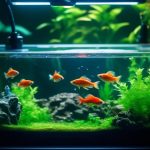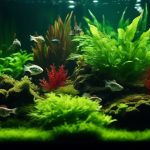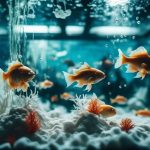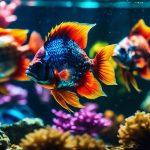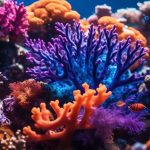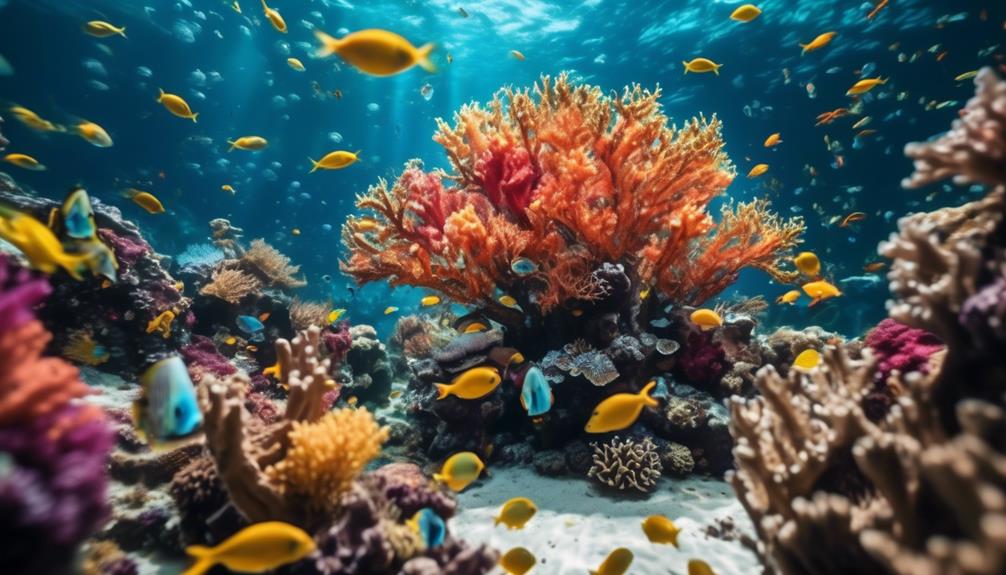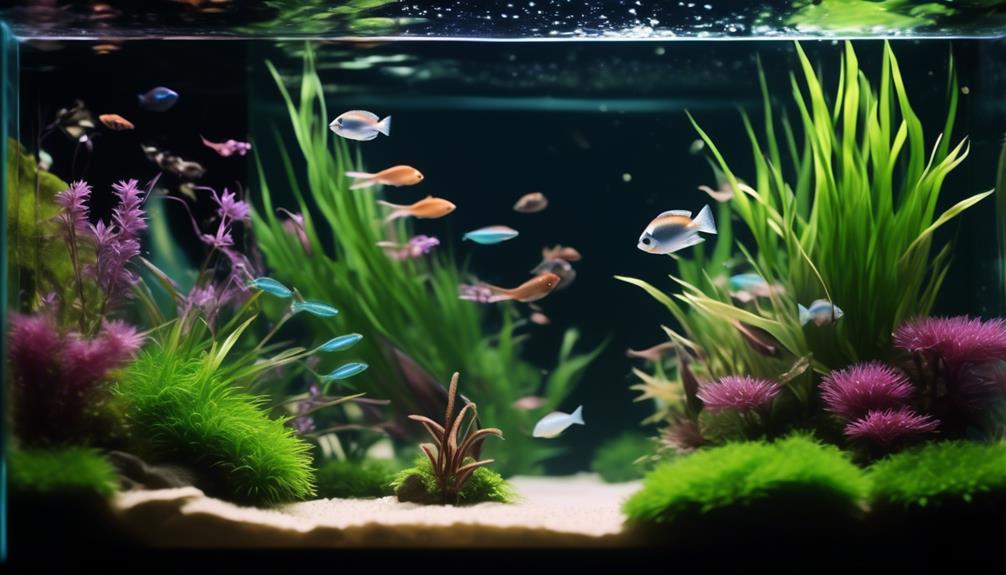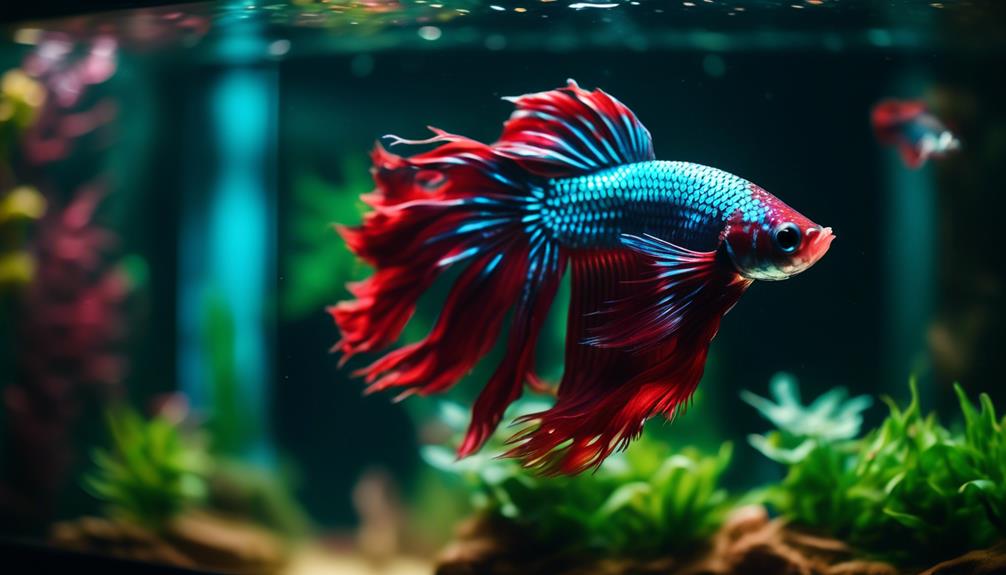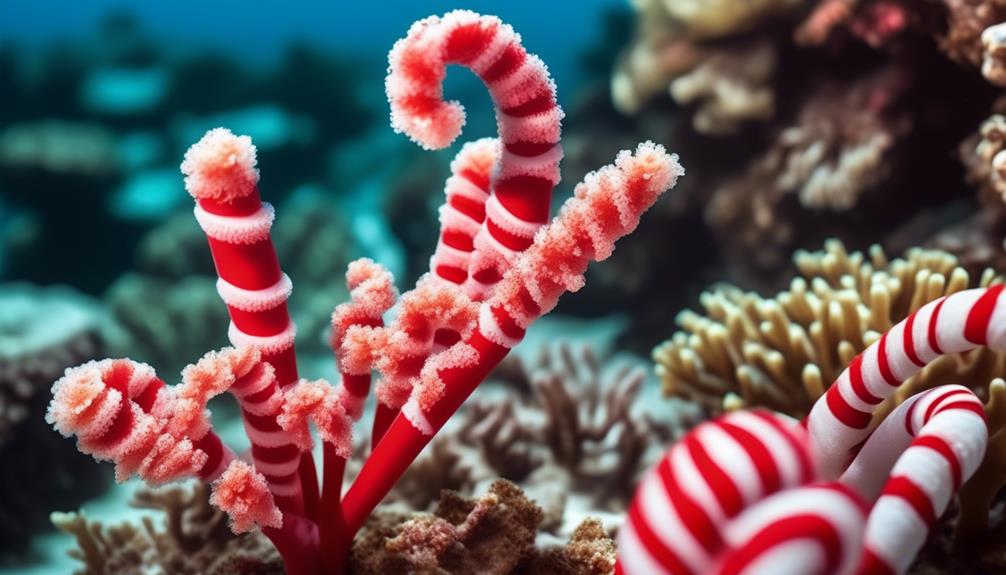Aquarium enthusiasts are always on the lookout for ways to enhance the beauty and vibrancy of their aquatic landscapes. One such way to achieve this transformation is by introducing the lush and visually captivating Dwarf Hairgrass.
With its turf-like appearance and elegant green blades, this versatile aquatic grass has become a popular choice among hobbyists. In this article, we will delve into the care and tank requirements of Dwarf Hairgrass, exploring everything from ideal water temperatures and lighting demands to propagation techniques and suitable tank mates.
But that's not all – we will also address common health concerns and provide tips for successful growth and maintenance.
So, if you're looking to take your aquarium to the next level, stay tuned to discover the wonders of this remarkable aquatic plant.
Key Takeaways
- Dwarf Hairgrass is a versatile aquatic plant that can create a beautiful carpet effect in aquariums.
- It requires proper water parameters, lighting, and trimming for successful growth and maintenance.
- The plant can be propagated through runners and offshoots, allowing it to spread and fill the tank.
- Ideal tank mates for Dwarf Hairgrass include neon tetras, black skirt tetras, danios, and livebearers, while corydoras, Oscar fish, and other cichlids should be avoided.
Care and Tank Requirements

When caring for Dwarf Hairgrass in an aquarium, it is essential to ensure proper tank requirements are met to promote its healthy growth and maintenance.
Choosing the right lighting for Dwarf Hairgrass is crucial as it has a moderate light demand. LED lights with a color temperature of around 6500K are recommended for optimal growth. These lights provide the necessary spectrum for photosynthesis and promote the development of lush green grass blades.
Additionally, the importance of water parameters cannot be overlooked for Dwarf Hairgrass growth. The ideal pH range for the plant is 6.5 to 7.5, and maintaining stable water conditions is essential. Regular monitoring of parameters such as temperature, pH, and nutrient levels is necessary to ensure the well-being of the plant.
Propagation and Tank Mates
Propagation of Dwarf Hairgrass can be achieved through the natural process of runners or by taking cuttings and planting them elsewhere in the substrate. Runners are thin stems that grow horizontally along the substrate, producing new offshoots and blades. This method allows the plant to spread and create a lush carpet effect in the aquarium. Another propagation technique is taking cuttings from the existing plant and planting them in different areas of the substrate. This helps to fill in bare spots and create a denser carpet.
When it comes to tank mates, it is important to choose species that are compatible with Dwarf Hairgrass. Suitable tank mates include neon tetras, black skirt tetras, danios, and livebearers. These fish are peaceful and won't disturb the delicate roots and blades of the grass. On the other hand, it is best to avoid tank mates such as corydoras, Oscar fish, and other cichlids, as they can uproot or damage the Dwarf Hairgrass. By selecting the right tank mates, you can ensure the healthy growth and maintenance of your Dwarf Hairgrass carpet.
| Suitable Tank Mates | Incompatible Tank Mates |
|---|---|
| Neon Tetras | Corydoras |
| Black Skirt Tetras | Oscar Fish |
| Danios | Cichlids |
| Livebearers |
Health Concerns and Maintenance
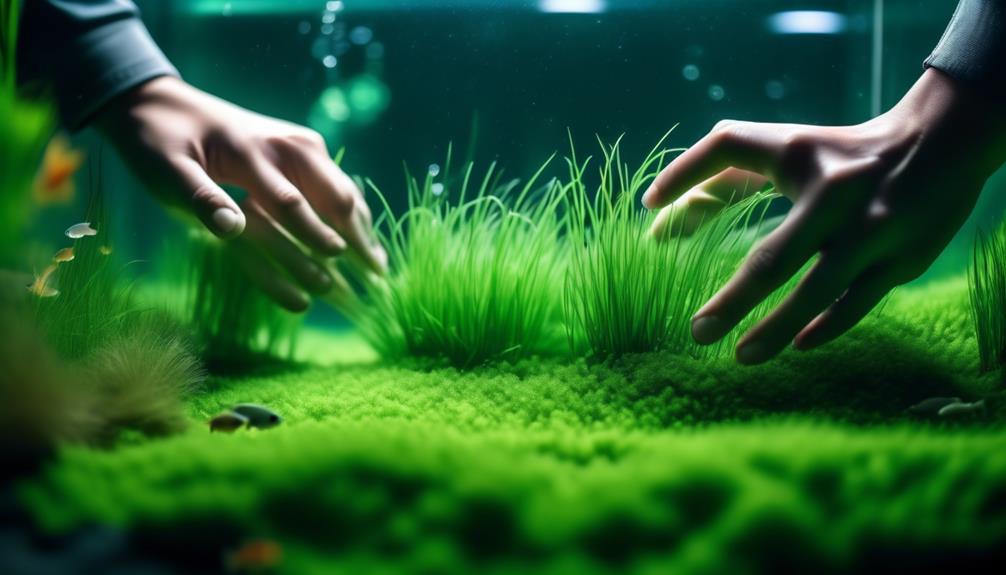
To ensure the long-term health and maintenance of Dwarf Hairgrass in your aquarium, it is important to address and prevent common health concerns through regular monitoring and maintenance. Here are some key steps to consider:
- Preventing nutrient deficiencies:
- Test water regularly to ensure proper nutrient levels.
- Provide a balanced fertilizer regimen to meet the plant's nutritional needs.
- Consider using root tabs or liquid fertilizers specifically formulated for aquatic plants.
- Avoid overfeeding fish, as excess nutrients can lead to algae growth.
- Dealing with algae growth:
- Maintain proper lighting levels to prevent excessive algae growth.
- Use a timer to ensure consistent lighting periods.
- Consider using algae-eating fish or invertebrates as natural control methods.
- Perform regular water changes to remove excess nutrients.
- Keep the aquarium clean by removing any decaying organic matter.
Ideal Tank Setup and Layout
An important aspect of maintaining Dwarf Hairgrass in your aquarium is creating an ideal tank setup and layout. This involves choosing the right lighting and creating a natural aquascape. When it comes to lighting, it is recommended to use moderate to high-intensity lights that provide a spectrum of wavelengths suitable for photosynthesis. This will ensure that the Dwarf Hairgrass receives the necessary light energy for growth. Creating a natural aquascape involves arranging the plants, rocks, and driftwood in a way that mimics a natural underwater environment. This can be achieved by placing taller plants towards the back of the tank and shorter plants, like the Dwarf Hairgrass, towards the front. Adding rocks and driftwood can also enhance the overall aesthetic appeal of the tank. By carefully considering the lighting and aquascape, you can create an environment that promotes the healthy growth of Dwarf Hairgrass and enhances the beauty of your aquarium.
| Lighting | Aquascape |
|---|---|
| Choose moderate to high-intensity lights | Arrange plants, rocks, and driftwood |
| Provide a suitable spectrum for photosynthesis | Mimic a natural underwater environment |
| Ensure sufficient light energy for growth | Place taller plants towards the back |
| Enhance the overall aesthetic appeal | Position Dwarf Hairgrass towards the front |
| Add rocks and driftwood for visual interest |
Benefits for Aquarium Ecosystem

Maintaining an ideal tank setup and creating a natural aquascape for Dwarf Hairgrass contributes to a balanced aquarium ecosystem with numerous benefits.
Some of the key benefits include:
- Oxygen production and water quality: Dwarf Hairgrass plays a crucial role in producing oxygen through photosynthesis, helping to maintain optimal oxygen levels in the aquarium. Additionally, the plant absorbs excess nutrients, such as nitrates and phosphates, which helps to improve water quality and reduce the risk of algae growth.
- Shelter and hiding places for aquatic life: The dense and lush growth of Dwarf Hairgrass provides excellent shelter and hiding places for small fish and invertebrates in the aquarium. This creates a more natural and stress-free environment for the inhabitants, allowing them to exhibit their natural behaviors and reducing the risk of aggression or predation.
- Enhanced aesthetics: The vibrant green carpet effect created by Dwarf Hairgrass adds visual appeal to the aquarium, giving it a more natural and lush appearance. This creates a visually pleasing and relaxing environment for both the aquarium owner and the inhabitants.
- Ecosystem balance: By absorbing excess nutrients and reducing algae growth, Dwarf Hairgrass helps to maintain a balanced ecosystem in the aquarium. This promotes the overall health and well-being of the inhabitants and reduces the need for excessive maintenance and interventions.
- Ecological diversity: The presence of Dwarf Hairgrass in the aquarium provides a habitat for a variety of microorganisms, beneficial bacteria, and other small organisms. This enhances the ecological diversity of the aquarium and contributes to its overall stability and resilience.
Tips for Successful Growth and Transformation
For optimal growth and transformation of Dwarf Hairgrass in your aquarium, implementing the following tips and techniques is essential.
First, ensure that the lighting requirements are met. Dwarf Hairgrass requires moderate to high lighting levels to thrive. Use full-spectrum LED lights or fluorescent bulbs with a color temperature of around 6500K. This will provide the necessary light energy for photosynthesis and promote healthy growth.
Additionally, regular trimming is crucial for maintaining the desired carpet effect. Use sharp, clean scissors to trim the grass blades to the desired height, removing any dead or decaying portions. This will encourage new growth and prevent the grass from becoming overgrown and suffocating.
Frequently Asked Questions
Can Dwarf Hairgrass Be Grown in a Low-Light Aquarium?
Yes, Dwarf Hairgrass can be grown in a low-light aquarium, but it may result in reduced growth. Alternatively, there are other carpeting plants that are more suitable for low-light conditions, such as Java Moss or Anubias Nana.
What Is the Recommended Water Hardness for Dwarf Hairgrass?
The recommended water hardness for dwarf hairgrass is between 3 to 8 dKH. While dwarf hairgrass can tolerate low light conditions, it may result in reduced growth. Adequate lighting and CO2 injections can enhance its growth potential.
Can Dwarf Hairgrass Be Grown With Other Carpeting Plants?
Yes, Dwarf Hairgrass can be grown with other carpeting plants in an aquarium. To maintain a healthy Dwarf Hairgrass carpet, provide adequate lighting, nutrient-rich substrate, and regular trimming to prevent shading and promote growth.
How Often Should Dwarf Hairgrass Be Fertilized?
Dwarf Hairgrass should be fertilized regularly to support its growth. Factors such as water parameters, lighting, and substrate quality can affect the plant's nutrient needs. Using a high-quality aquarium fertilizer specifically formulated for aquatic plants is recommended for best results.
Can Dwarf Hairgrass Be Grown in a Saltwater Aquarium?
No, Dwarf Hairgrass cannot be grown in a saltwater aquarium. It is a freshwater plant that thrives in brackish water conditions. The benefits of Dwarf Hairgrass in a saltwater tank include providing oxygen and maintaining water quality.
